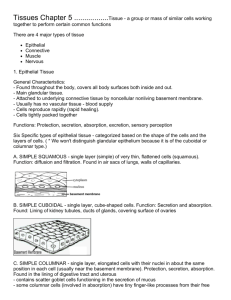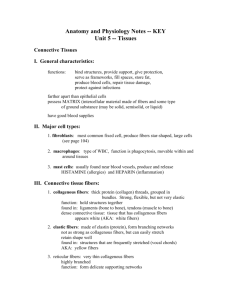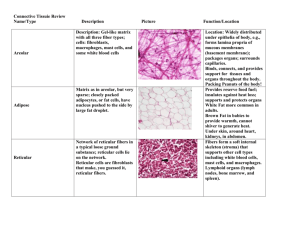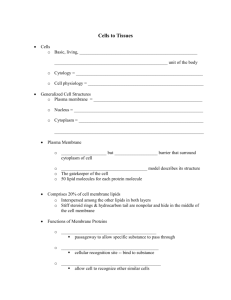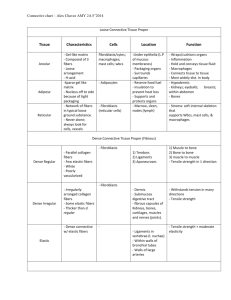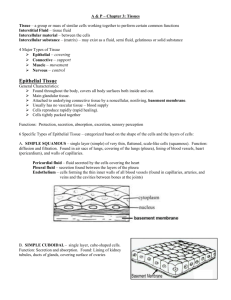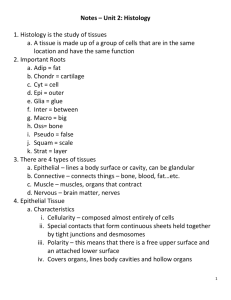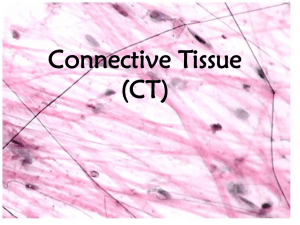File
advertisement
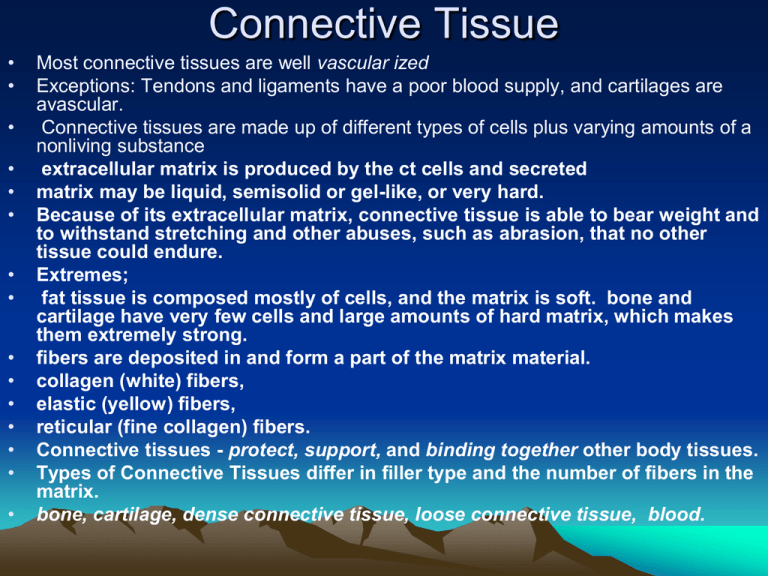
Connective Tissue • • • • • • • • • • • • • • • Most connective tissues are well vascular ized Exceptions: Tendons and ligaments have a poor blood supply, and cartilages are avascular. Connective tissues are made up of different types of cells plus varying amounts of a nonliving substance extracellular matrix is produced by the ct cells and secreted matrix may be liquid, semisolid or gel-like, or very hard. Because of its extracellular matrix, connective tissue is able to bear weight and to withstand stretching and other abuses, such as abrasion, that no other tissue could endure. Extremes; fat tissue is composed mostly of cells, and the matrix is soft. bone and cartilage have very few cells and large amounts of hard matrix, which makes them extremely strong. fibers are deposited in and form a part of the matrix material. collagen (white) fibers, elastic (yellow) fibers, reticular (fine collagen) fibers. Connective tissues - protect, support, and binding together other body tissues. Types of Connective Tissues differ in filler type and the number of fibers in the matrix. bone, cartilage, dense connective tissue, loose connective tissue, blood. Areolar or Loose • Structure: Cells (e.g., fibroblasts, macrophages, and lymphocytes) within a fine network of mostly collagen fibers. Often merges with denser connective tissue. • Location: Widely distributed throughout the body; substance on which epithelial basement membranes rest; packing between gland, muscles, and nerves. Attaches the skin to underlying tissues. • Function: Loose packing, support, and nourishment for the structures with which it is associated. Dense Regular Collagenous • fibroblasts (A) are more • Structure: Matrix composed of collagen fibers running in clearly observed between somewhat the same the parallel collagenous direction. fibers (B). Whitefibrous tissue (tendon) fibroblasts (A) are more clearly observed between the parallel collagenous fibers (B). • Location: Tendons (attach muscle to bone) and ligaments (attach bones to each other). • Function: Ability to withstand great pulling forces exerted in the direction of fiber orientation, great tensile strength, and stretch resistance. Dense Regular Elastic • Structure: Matrix composed of regularly • Yellow elastic (slide is arranged collagen fibers from nuchal ligament) and elastin fibers. • Location: Ligaments between the vertebrae and along the dorsal aspect of the neck (nucha) and in the vocal cords. • Function: Capable of stretching and recoiling like a rubber band with Yellow elastic (slide is from nuchal strength in the direction ligament) of fiber orientation. Dense Irregular Collagenous • Structure: Matrix composed of collagen fibers that run in all directions or in alternating planes of fibers oriented ina somewhat single direction. • Location: Aponeuroses and sheaths; dermis of the skin; organ capsules and septa; outer covering of body tubes. • Function: Tensile strength capable of withstanding stretching in all directions. Dense Irregular Elastic • Structure: Matrix composed of bundles and sheets of collagenous and elastin fibers oriented in multiple directions. • Location: Elastic arteries • Function: Capable of strength with stretching and recoil in several directions. Adipose Tissue • Structure: Little extracellular material surrounding cells. The adipocytes, or fat cells, are so full of lipid that the cytoplasm is pushed to the periphery of the cell. • Location: Predominantly in subcutaneous areas, mesenteries, renal pelvis, around kidneys, and attached to the surface of colon. Where loose connective tissue penetrates into spaces and crevices. • Function: Packing material, thermal insulator, energy storage, and protection of organs against injury from being bumped or jarred. Reticular • Structure: Fine network of reticular fibers irregularly arranged. • Location: Within the lymph nodes, spleen, and bone marrow. • Function: Provides a superstructure for the lymphatic and hemopoietic tissues. Bone Marrow • Structure: Reticular framework with numerous blood-forming cells (red marrow). • Location: Within marrow cavities of bone. – Two types: • Yellow Marrow (mostly adipose tissue) in the shafts of long bones • Red Marrow (hemopoietic or blood-forming tissue) in the ends of long bones and in shor, flat, and irregularly shaped bones. • Function: Production of new blood cells (red marrow). Hyaline Cartilage • Structure: Collagen fibers of cartilage type that are small and evenly dispersed in the matrix, making the matrix appear transparent. The cartilage cells, or chondrocytes, are found in spaces, or lacunae, within the rigid matrix. • Location: Growing long bones, cartilage rings of the respiratory system, costal cartilage of ribs, nasal cartilage, articulating surface of bones, and the embryonic skeleton. • Function: Allows growth of long bones. Provides rigidity with some flexibility in the trachea, bronchi, ribs, and nose. Forms rugged, smooth, yet somewhat flexible articulating surfaces. Forms the embryonic skeleton. Fibrocartilage • Structure: Collagenous fibers similar to those in hyaline cartilages and the more general type of collagen fibers in other connective tissues. The fibers are more numerous than in other. • Location: Intervertebral disks, symphysis pubis, articular disks (e.g., knee and temporomandibular [jaw] joints), and the round ligament. • Function: Somewhat flexible and capable of withstanding considerable pressure. Connects structures subjected to great pressure. Elastic Cartilage • Structure: Similar to hyaline cartilage, but matrix also contains elastin fiber. • Location: External ear, epiglottis, and auditory tube. • Function: Provides rigidity with even more flexibility than hyaline cartilage since elastic fibers return to their original shape after being stretched. Cancellous Bone • Structure: Latticelike network of scaffolding characterized by trabeculae with large spaces between them. The osteocytes, or bone cells, are located within lacunae in the trabeculae. • Location: In the interior of the bones of the skull, sternum, and pelvis. Also found in the ends of the long bones. • Function: Acts as a scaffolding to provide strength and support without the greater weight of solid bone. Compact Bone • Structure: Hard, bony matrix predominates. Many osteocytes are located within lacunae that are distributed in a circular fashion around the central canals. Small passageways connect adjacent lacunae. • Location: Outer portions of all bones and the shafts of long bones. • Function: Provides great strength and support. Forms a solid outer shell on bones that keeps them from being easily broken or punctured. Blood • Structure: Blood cells and a fluid matrix. • Location: Within the blood vessels. Produced by the hemopoietic tissues. White blood cells frequently leave the blood vessels and enter the interstitial spaces. • Function: Transports oxygen, carbon dioxide, hormones, nutrients, waste products, and other substances. Protects the body from infections and is involved in temperature regulation.
